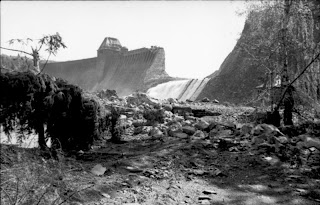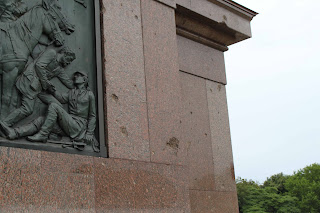In Berlin, the Brandenburg Gate is considered to be the most visited site in the city, mainly due to its rich history and its modern symbolism of reunified Germany. However, one block down from the Gate is the second most visited site in Berlin: the Reichstag building. Home to the modern day German parliament, the Bundestag, the Reichstag building itself has a rich history which includes the role the building played in the creation of the Nazi dictatorship in 1933.
 |
| Reichstag circa 1900 |
The building was constructed in the mid 1880s, in order to house the parliaments of the recently united German states. It was during its construction that the famous words "Dem Deutschen Volke", or "For the German People", were etched on the front of the building, over the objections of Kaiser Wilhelm II due to its democratic implications. The building became the site of many political rallies during the First World War, such as those celebrating the start of the war. Into the Weimar Republic, other rallies were held to protest the harshness of the Versailles Treaty. However, it is in 1933 that the building became the center of fear and hysteria.
In 1933 Adolf Hitler had been recently appointed Reichschancellor by President Paul von Hindenburg, the former supreme army commander during WWI. However, Hitler's power was still tempered by the chain of command in the Weimar government, which said that while the chancellor had most executive powers, he could still be overruled by the President. There was a way around this, however. In the Weimar constitution, there is a bill that states that the Chancellor could be given emergency powers in the event of a threat to the security of the government and the nation. Hitler, of course, did not wait for crisis to occur on its own.
 |
| The Reichstag on fire 2/27/33 |
On the night of February 27, a fire broke out in the Reichstag building.This fire destroyed much of the inside structure, but the building itself still stood. The real effect of the fire was of a political nature. Hitler immediately claimed that the fire was set on orders from the German Communist Party, coincidentally the Nazi party's biggest rival in the parliament. It was on this basis, that the Communists were preparing to overthrow the Weimar government, that President Hindenburg granted Hitler the emergency powers he had asked for. This allowed Hitler to arrest many Communists, effectively disposing of Hitler's last rival.
Also, because Hitler possessed emergency powers, he was able to pass the Enabling Act, which effectively suspended all civil liberties. Finally, it was through these powers that Hitler was able to merge the offices of President and Chancellor, making himself the de facto dictator of Germany. Meanwhile, the responsibility of the Reichstag Fire was pinned on Dutch communist Marinus van der Lubbe, who was summarily executed. Interestingly enough, the events that took place in Germany at this time are almost paralleled in the Star Wars prequel movies regarding Senator/chancellor/Emperor Palpatine.
Historians have argued for many years about whether van der Lubbe was acting on orders from the Communist party, the Nazi party, or whether the SA, the Nazi's police force, had set the fire themselves and van der Lubbe was a convenient scapegoat. To this day the motives and plots surrounding the Reichstag fire remain a mystery.

During the war, the Reichstag was never repaired, because the Nazis had effectively disbanded the parliament and built a new executive building. The building was damaged further by Allied bombings of Berlin, and in the Soviet's offensive on the city considerable manpower was channeled into capturing the building due to its symbolic standing. The photo of a Soviet soldier placing the flag on the Reichstag was, in fact, staged. The Soviets had taken the building three days prior.
After the war, the building was essentially an abandoned ruin. A half-hearted restoration was undertaken in the 1960s to protect the building from the elements, but because both East and West Germany had no need of it, the building lay unrestored until the fall of the Berlin Wall. After the Wall fell, the decision was made to make Berlin the capital of Germany again, and the building was 'restored', by this I mean everything but the outside walls was completely redone. Also, because the cupola, the dome on top, was severely damaged, a new glass dome was affixed to the building. Today, the Reichstag houses the German parliament and remains a popular tourist attraction.
 |
| Soviet graffiti in the Reichstag |
In summary, the Reichstag building served as both a symbol of unity and a means of political upheaval in its lifetime. Without the Reichstag Fire, Hitler's power may have been tempered up to Hindenburg's death in 1934, in which case who knows how he might have become dictator, if at all. Until next time, take care, and thank you for reading.



































